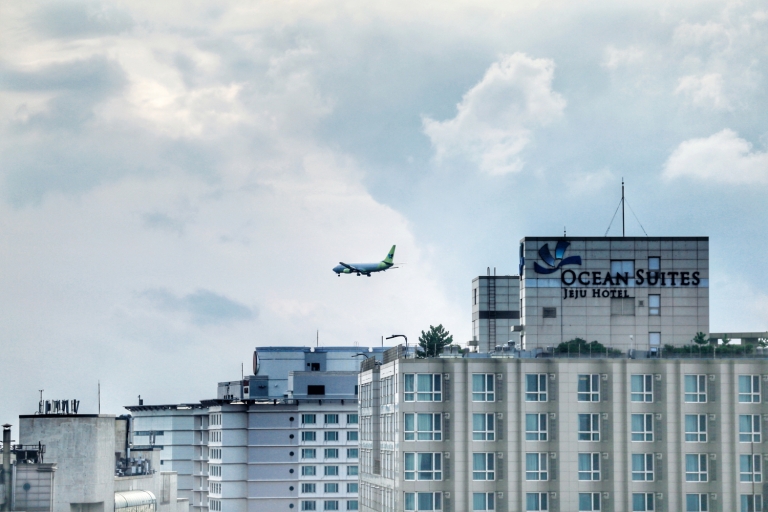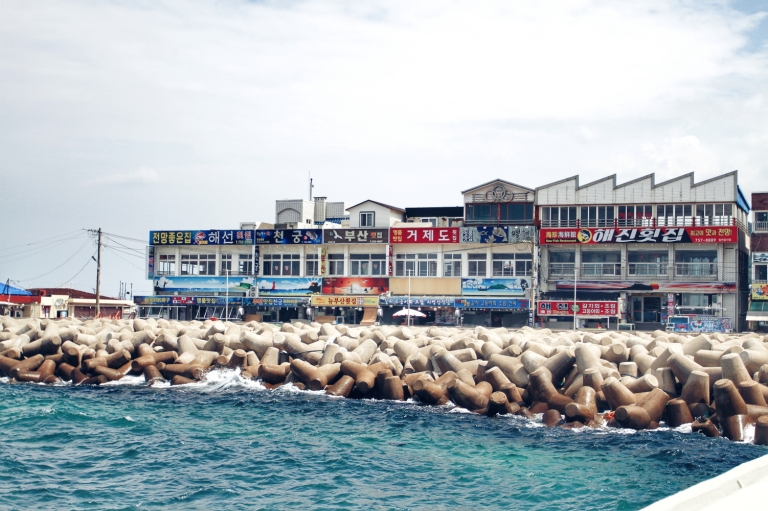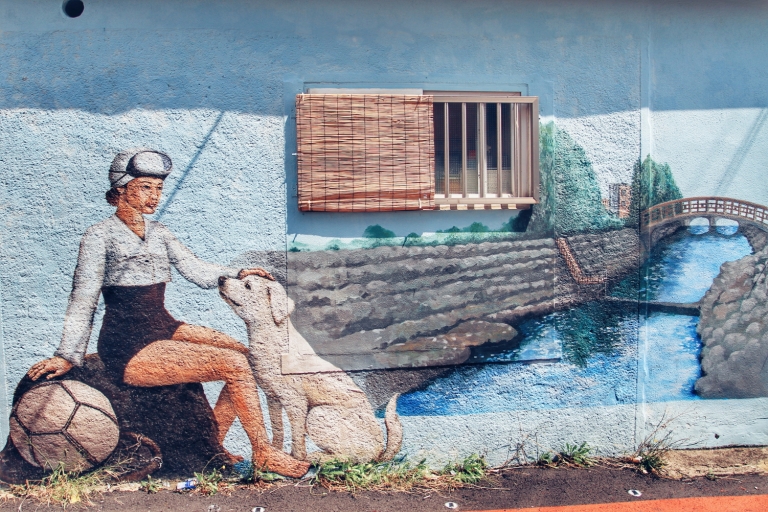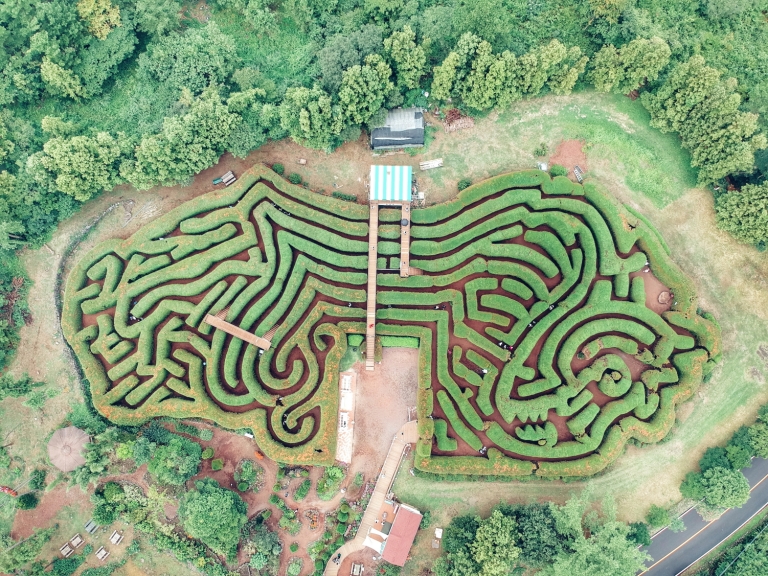RO: Nu c-am vrea sa incepem intr-o nota negativa (pentru ca in final, dupa multe bombaneli, chiar ne-a placut insula), insa credem ca e cinstit sa spunem ca este putin exagerata si pe alocuri nerealista comparatia insulei Jeju cu Hawaii sau Bali. Pentru ca da, orice ghid turistic va ridica in slavi insula Jeju si-o va numi Paradisul Coreei, Hawaii-ul din Est, o insula de o frumusete rar intalnita pe Pamant, cu plaje incredibil de spectaculoase si atractii turistice senzationale. Iar lucrurile nu stau tocmai asa, desi recunoastem ca ne-am lasat si noi influentati de toate recenziile gasite pe internet si parca-parca ne si vedeam cu ghirlande cu flori pe dupa gat si fuste hula-hula 🙂 Adevarul e ca-s tare buni coreenii cand vine vorba de marketizat tara lor, si bine fac pana la urma, ca doar nu degeaba or fi zboruri catre Jeju la fiecare cinci minute dinspre Seoul. Zboruri complet pline, pan’ la ultimul locsor.
EN: Not that we would like to start the article on a negative note (because in the end, after grumbling quite a lot, we truly liked the island), but we believe that it would be more sincere to say that the comparison of Jeju island with Hawaii or Bali is a bit exaggerated or even unrealistic. Because yes, indeed, every touristic guide will praise Jeju island to the skies and will probably call it the Korean Paradise, the Hawaii of the East, a rarely seen beautiful island, with incredible and spectacular beaches and exceptional touristic attractions. But the truth is not precisely this one, even though we have to admit that we were influenced by all the reviews found on the internet and we always seen ourselves with flower garlands around our new and hula-hula skirts 🙂 Well, the Koreans are very competent when it comes to promote their country, and it seems to be working, as there are flights from Seoul to Jeju every five minutes. Completely full flights, with each and every single seat occupied.

RO: Si inainte de a incepe cu cele cateva locuri pe care le-am descoperit pe insula, ar fi de mentionat vreo doua aspecte administrative, nu de alta, dar sa evitam enervarile inutile la fata locului. Prima si cea mai previzibila de altfel, e ca lumea nu vorbeste limba engleza aproape deloc (desi este un punct extrem de turistic). Asta poate fi o problema destul de mare cand vrei sa cumperi un bilet de autobuz spre exemplu 🙂 Noi am rezolvat problema aceasta avand intotdeauna scris in telefon destinatia unde voiam sa ajungem, atat in engleza cat si in coreeana, in alfabet hangul. A doua e faptul ca este nevoie de permis international de conducere pentru a inchiria masina (cel de Romania nu este de ajuns, la fel cum nici traducerea in engleza de o firma specializata nu este acceptata). Chiar si pentru un scuter mic e aceeasi poveste. Distantele sunt mari, in orice directie ai vrea sa mergi inafara orasului Jeju, iar multe dintre locurile in care chiar este de ajuns, sunt mai greu accesibile. Am mai dat de problema permisului international si in Noua Zeelanda, probabil ca intelept ar fi fost sa ni-l fi facut deja. Insa pur si simplu nu am vrut sa platim cei 900 ron ACR-ului pentru un serviciu pe care Germania (sau orice alta tara europeana) iti cere 50 de euro. O alta problema ar fi bancomatele, care de cele mai multe ori nu accepta carduri straine (exceptie fac bancile), deci preferabil ar fi de venit cu bani cash. Si cea mai enervanta dintre toate, e faza cu inchiderea sezonului turistic. Daca pe 31 august totul e plin de viata si agitatie, la 1 septembrie totul se inchide complet. Hoteluri, restaurante, piscine, plaje inchise (pana si robinetii dusurilor sigilati!), totul pare complet mort, chiar daca vremea este inca buna si turistii inca mai vin.
EN: But before starting with the places we’ve discovered on the island, we should mention several administrative aspects, so that we can avoid unnecessary inconveniences. The first one – and the most predictable one, is that people do not speak English almost at all (even though this place is extremely touristic). And that can be quite a problem when you want to buy a bus ticket for example 🙂 We solved this problem by always having in written the destination where we wanted to get to, in both English and Korean, in hangul alphabet. The second one is the fact that you need an international driving license in order to rent a car (the Romanian one is not enough, and an authorized translation is not accepted). Even for a small scouter there is the same story. The distances are long, no matter where you would go outside Jeju city, and most of the iconic places are not quite easy to reach. We had the same problem with the international driving licence in New Zealand, so it would have been wise to have it already. But we simply didn’t want to pay 900 ron for ACR for a service that Germany (or any other European country) asks 50 euros. Another problem would be the ATMs, which rarely accept foreign cards (except the banks) so cash is preferred. And the most annoying of them all is the closing of the summer season. If on 31st of August everything is full of life and hustle and bustle, on 1st of September everything closes completely. Hotels, restaurants, pools, beaches, everything is closed (even the shower taps are sealed!) even though the weather is still good and there are still lots of tourists coming here.

RO: Iar ultima, si cea mai importanta am spune noi, e locatia. Clar am recomanda oricui sa stea cazat in partea sudica a insulei, in zona Seogwipo si nicidecum in nord, in capitala Jeju City, un oras aglomerat, plin de constructii, bulevarde, trafic si tepe turistice. Cum ar fi spre exemplu renumita Seafood Street, plina de restaurante pescaresti unde o portie de sashimi trece de 100 de dolari. Cert e ca partea de nord a insulei nu are foarte multe de oferit, iar pentru cei care nu au masina de inchiriat, poate fi mai convenabil un hotel in sud. In orice caz, nu-i foarte complicat nici mersul cu autobuzul, ba chiar dimpotriva, la terminalul de autobuze din Jeju City exista un birou de informatii special pentru turisti, unde angajatii vorbesc un picut de engleza si indruma oamenii catre linia de autobuz care duce la destinatia dorita. A, si orice bilet de autobuz costa 1200 won (mai putin de 1 euro), indiferent de cate statii mergi 🙂 Un chilipir! Apropo, pentru problema cu engleza, exista un serviciu de traducere pentru turisti, un fel de 112 al nevorbitorilor de coreeana 🙂 Si-ar mai fi apoi varianta deplasarii cu taxiurile, care desi sunt destul de ieftine, tot ar ajunge destul de mult pentru drumurile de 20-30 km dintre atractii. Am auzit si de varianta inchiriatului unui taxi pe o zi intreaga, insa pretul de 150.000 won ni s-a parut exagerat.
EN: The last one and the most important one, is the location. For sure we would recommend booking a hotel in the southern part of the island, in the Seogwipo area and not in the north, in Jeju City, a crowded city, full of constructions, boulevards, traffic and all kind of tourist scams. As an example, the famous Seafood Street, full of seafood restaurants where a sashimi dish is more than 100 dollars. And to be honest, the northern part of the island does not have too much to offer, and for those who don’t have a rental car, it can be more convenient to stay in a hotel in the south. Anyway, travelling by bus is not too complicated either, actually on the contrary, at the bus terminal in Jeju City there is an information office for tourists, where the employees speak a bit of English and guide the tourists to the correct bus line depending on the desired destination. Ah, and each bus ticket only costs 1200 won (less than 1 euro), no matter how many stations you’ll travel 🙂 What a bargain! And by the way, for any kind of translation problems, there is a special service for tourists, a kind of 911 for those who don’t speak Korean 🙂 And there’s always the option of travelling by cab, which are quite cheap, but in the end they are way too much for a 20-30 km ride between the attractions. We also heard about renting a cab for an entire day, but the price of 150.000 wons (~110 euros) seemed to be exaggerated for us.








RO: Buuun, si acum ce ar fi de vazut pe Jeju. Scoatem din start de pe lista parcurile tematice, Hello Kitty-uri, Teddy Bear-uri, parcurile erotice si alte bazaconii de atractii inventate 🙂 Si ne focusam pe doua-trei plaje spectaculoase si peisaje frumoase. Multumita Alinei (@gothru_media) care ne-a scris pe Instagram, am dat de site-ul acesta, cu fotografii din drona facute de un sud coreean, care prezinta mai toate punctele de interes de pe insula (http://thevr.co.kr/thevr_360image/jeju/ ). Noi chiar l-am folosit si ne-am ghidat dupa el cand am ales sa vizitam una dintre cele mai populare plaje din nord-estul insulei, plaja Gimnyeong. Care da, recunoastem ca are atuurile ei, cu rocile negre vulcanice, nisipul alb si mini golfurile de apa turcoaz. Peisajul e intr-adevar dramatic si frumos, insa ne-a parut putin dezolant din cauza sezonului inchis, totul parea de-a dreptul abandonat. Mai aveam pe lista de recomandari si plaja Hamdeok, insa din cauza vremii am renuntat sa o mai vedem.
EN: Ok, and now let’s see what is there to see on Jeju island. We’ll skip the themed parks, Hello Kitty, Teddy Bear, the erotic parks and other invented attractions 🙂 And we’ll focus on several spectacular beaches and nice landscapes. Thanks to Alina (@gothru_media) who wrote us on Instagram, we found this website, with drone photographs made by a South Korean photographer that presents all the interesting places to see on the island (http://thevr.co.kr/thevr_360image/jeju/ ). We actually used it and guide our itinerary based on his recommendations and that’s how we got to Gimnyeong beach in the north east part of the island. Which is indeed beautiful with its black volcanic rocks, the white sand and those tiny gulfs in the turquoise water. The scenery is dramatic and beautiful, but it seemed a bit desolated due to the closing of the season, everything seemed completely abandoned. We also had on the list the Hamdeok beach, but due to the bad weather we couldn’t see it.



RO: Tot in zona aceasta ar fi si pesterile de la Manjanggul, unde se poate vizita tubul de lava, insa din pacate noi am nimerit intr-o sarbatoare nationala cand surpriza… era inchis 🙂 Asa ca am ramas la labirintul din apropiere, Jeju Maze Park, nu tocmai fabulos ca atractie si pe care nu il recomandam neaparat, dar ne-a tinut in priza cu joaca cu drona. Si pisicile 🙂
EN: In the same area there are the Manjanggul Caves, where the lava tube can be seen, but unfortunately we’ve been there on a public holiday and… it was closed 🙂 So we stayed at the nearby maze, Jeju Maze Park, not precisely the most fabulous attraction, which we don’t necessarily recommend, but it gave us a good reason to play with the drone. And the cats 🙂

RO: Daca am fi avut masina, am fi mers mai mult in partea estica si am fi vizitat si varful Seongsan Ilchulbong (Sunrise Peak) si al sau crater vulcanic de unde se spune ca s-ar vedea niste apusuri exceptionale. A si apropo, Varful Apusului, precum si insula Udo (varianta in miniatura a insulei Jeju) sunt faimoase pentru asa numitele “haenyeo“, niste doamne respectabile in jurul varstei de 80 de ani (uneori si mai bine de atat), care se scufunda in apele marii fara tuburi de oxigen pentru a aduna arici de mare, castraveti de mare, melci abalone si alte ciudatenii marine. Ce-i drept, meseria de haenyeo nu mai este de mult atat de cautata printre locuitorii insulei Jeju, ba mai mult, pare ca urmeaza sa dispara. Din ce in ce mai putine femei sunt dispuse sa isi asume un risc atat de mare pentru a-si asigura un venit si pare ca ar cam fi ultima generatie de haenyeo din Coreea de Sud. Probabil din acest motiv au si devenit atat de renumite, pentru ca pastreaza o traditie sud coreeana care tinde sa se piarda in curand.
EN: If we would have had a rental car, we would have visited more of the eastern part of the island and see the Seongsan Ilchulbong with its volcanic crater from where people say one can see some spectacular sunsets. And by the way, the Sunrise Peak as the name translates into English, and Udo Island (the miniature alternative of Jeju island) are famous for the so called “haenyeo“, some respectable ladies around 80 years (or even more), that dive in the waters of the sea without oxygen tubes to gather sea urchins, sea cucumbers, abalone snails and other marine weird creatures. To be more precise, the haenyeo occupation is not a desired one anymore among the locals of Jeju island, and even more than that, it might disappear soon. Less and less women dare to take such a big risk in order to provide for their families and this seems to be the last generation of haenyeo in South Korea. Maybe that why the female divers have become so renowned, because they still keep a South Korean tradition that will soon end.

RO: Partea vestica e mai putin marketizata si mai putin vizitata de turisti, insa are plaja Hyeopjae, un soi de Paradis hipsteresc sud coreean. Care intre noi fie vorba, nu pare sa aiba ceva extraordinar de oferit – exceptand poate rocile vulcanice si peisajul dramatic. Asta pana cand o vezi la reflux si iti pare ca scoasa din alta lume. Si se continua cu plaja Geumneung (intre cele doua se gasesc o multime de bangsatap, turnulete din pietre, menite sa fereasca oamenii de ghinion) chiar mai frumoasa ca prima, iar vizavi de cele doua plaje se afla parcul Hallim, renumit de altfel pentru plantele subtropicale si pentru pesterile Hyeopjaegul si Ssangyonggul. A si apropo, pe plaja Geumneung am dat pentru prima oara de statuile dol hareubang, simbolul insulei Jeju care ar aduce localnicilor protectie si fertilitate. Totusi, preferata noastra ramane partea sudica, insa despre aceasta vom vorbi in cea de-a doua parte a articolului despre insula Jeju.
EN: The west part of the island is less known or visited by the tourists, but it has Hyeopjae Beach, a kind of hipsterish South Korean Paradise. Between you and me, it does not seem to have something extraordinary to offer – except the volcanic rocks and the dramatic scenery. But that’s only until you see it at low tide and it looks like it would have been taken out if this world. And it continues with Geumneung Beach (between the two of them there are a lot of bangsatap, small little towers made of rocks, used to protect the locals from bad luck) which is even more beautiful than the first one, and in front of the beaches there is Hallim Park, renowned for the subtropical plants and the Hyeopjaegul and Ssangyonggul caves. Ah, and by the way, on the Geumneung Beach we found for the first time the dol hareunbang statues, the symbol of Jeju island which is said to bring fertility and protection for the locals. However, our favourite part of the island is the southern one, but we’ll talk more about it in our second part of the Jeju island article.









